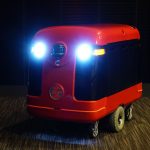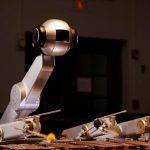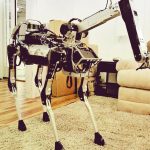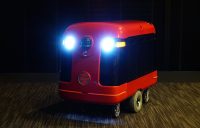Beyond BB-8: Why Toymaker Sphero Is Launching An Autonomous Home Robot Company
If attendees at this year’s CES took a moment to remove their virtual reality headsets, they might have spied a bunch of new home robots that debuted in Vegas. Unlike the toy bots that have driven, crawled, and flown around tech shows for years, these next-generation machines promise to not only entertain but also help out with tasks such as home security. They also aim to act like Amazon Echo speakers on wheels, answering questions and controlling smart home functions. The transition from plaything to domestic help is embodied in toymaker Sphero‘s launch today of spin-off company Misty Robotics after 18 months as a stealth project.
“It’s explicitly not a toy. Our business isn’t about toys, and so it’s spinning out,” says Tim Enwall, Misty’s CEO. (Sphero cofounder Ian Bernstein will serve as head of product.) Autonomous robots would seem to be a big transition from Sphero’s roots, beginning with its eponymous product, essentially a smartphone-controlled cue ball that started rolling around floors in 2011. The ball gained a head and basic intelligence in 2015 as a wildly popular $150 toy version of the BB-8 droid from Star Wars: The Force Awakens. There are some clues to Misty’s capabilities in Sphero’s latest toys, though. They include an agile, talking Lightning McQueen car tied to the debut of Disney’s new Cars 3 animated film and a wisecracking Spider-Man doll arriving shortly before the latest Marvel franchise release.

I asked Enwall about the technological jump from Sphero’s simple toys to autonomous robots. Sphero, he said, has “built robots targeted at young kids where the robots . . . don’t have a lot of AI, don’t have a lot of personality,” he said. But he added that a lot of artificial intelligence development has been going on in the secret lab at Sphero.
“The robotic being of the future, the one that’s going to go into everyone’s home or office, it has to build a relationship. It has to be familiar,” says Enwall. “It has to be useful, and it has to be multipurpose.” Don’t expect Rosie the Robot from The Jetsons, however. “The technology is not at the point where Rosie has hands and cruises around and does the dishes,” he says.
Mysterious Misty
Misty hasn’t provided a name, price, or comprehensible image for its robot, which Enwall says will debut sometime in 2018. The company has released only a hilariously vague image showing the left edge of what appears to be a white robot’s head and shoulder. Even that is just, “roughly the kind of thing we’re talking about,” says Enwall. The company likely has a more developed concept under wraps, however, to attract $11.5 million in funding from investors Venrock and Foundry Group. Misty is already planning construction of the robots. I spoke to Enwall hours after he’d returned to California from a meeting in China with manufacturing partner Jetta, the same company that makes Sphero’s toys.
Enwall hints that Misty’s product will be more sophisticated than the robots that debuted at CES, such as Kuri, a $699 model from Mayfield Robotics (an offshoot of German tech giant Bosch), due to ship in spring 2018. Kuri can wheel around the house, using cameras, microphones, speakers, and artificial intelligence to recognize people and understand questions and requests—the next stage beyond smart speakers like Amazon’s Echo and Google Home, says Berkeley robotics professor Ken Goldberg, who is not affiliated with Sphero. “The device will now . . . have some moving component, so it can essentially look around, and it can also respond in terms of motion to different cues,” says Goldberg, mentioning duties like identifying guests or intruders, or taking photos at parties. Enwall mentions keeping an eye on the condition of elderly family members, too.
Misty’s teaser image hints at a humanoid form, perhaps more like Softbank’s Pepper, a business-grade robot that performs duties like in-store customer service in Japan and beyond. Enwall stresses that Misty’s bot will be a serious multitasker, performing the duties that would otherwise require several robots adding up to $2,500 or more. “I think that would be too much,” he says of such a price tag. In addition to being a mobile digital assistant, it appears that Misty will be able to do some physical work. Enwall mentions examples such as watering plants and playing with the cat. (Of course, cats would likely play with a robot whether or not it was designed with that purpose in mind.)
Enwall isn’t simply being coy about what Misty’s robot can do: Its capabilities will be up to the tinkerers who buy the first model. Like Softbank’s Pepper, Misty’s robot will begin as a developer platform. “We’re focused on innovators who take to early robots and do a zillion things that they have in their brains but they’ve never been able to do before,” says Enwall. He does foresee a broad range of applications, saying that before Misty recruited him, he had been looking for “ideas in the area of smart home, elder care, robotics, and voice interfaces. And you know, this opportunity landed in my lap, and I was like, ‘Hey, that’s all of them,’” he says.
Misty’s robot probably won’t be landing in the homes of anyone other than early adopters and makers at first, but versions customized by entrepreneurs may reach consumers in later years. “I think this whole notion of an independently mobile, independently seeing, speaking, hearing entity . . . that’s something that’s maybe just starting to reach the mainstream,” says Enwall. “Our ambition is certainly to deliver [a robot] to every home and every office. But we’re not ready yet to walk into Target, see Rosie on the shelf, and walk out with it.”
The Next Tech Product Boom?
Misty is not the first company to develop consumer-priced home robotic helpers, and won’t be the last. Mayfield Robotics appears to be one of the furthest along, if it keeps to its 2018 delivery promise. Dates tend to slip, though. Tabletop home assistant Jibo was unveiled in 2014, although it’s yet to ship, and the company has been vague about when that might happen. A device similar to Jibo, the LG Hub Robot, debuted as a prototype at CES 2017 with no firm shipping date.
Misty might also keep an eye on Sphero’s well-funded rival toymaker Anki. Started by roboticists from Carnegie Mellon University, Anki has been building AI into its robotic toys since the company’s founding in 2010. Its $180 Cozmo, for instance, is a mischievous robot that zips around on tank-like tracks. Debuting in 2016, Cozmo recognizes different users, with whom it plays games like stacking and knocking over special toy blocks. Cozmo emits beeps and bloops as dialog and displays facial expressions on its small front screen. Anki also builds autonomous toy race cars, including a Fast & Furious-licensed line. With $157.5 million in funding according to Crunchbase, Anki–which has always said it aspires to be more than a toy company–has the cash on hand to go beyond creating playthings.
After 18 months of stealth development, Sphero’s autonomous robot lab debuts as Misty Robotics, promising an affordable home helper in 2018.
If attendees at this year’s CES took a moment to remove their virtual reality headsets, they might have spied a bunch of new home robots that debuted in Vegas. Unlike the toy bots that have driven, crawled, and flown around tech shows for years, these next-generation machines promise to not only entertain but also help out with tasks such as home security. They also aim to act like Amazon Echo speakers on wheels, answering questions and controlling smart home functions. The transition from plaything to domestic help is embodied in toymaker Sphero‘s launch today of spin-off company Misty Robotics after 18 months as a stealth project.
Fast Company , Read Full Story
(41)













